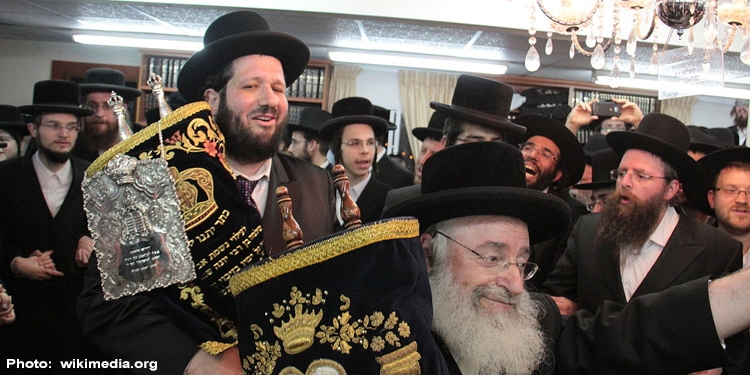What Are Shemini Atzeret and Simchat Torah?

Immediately following the joyous festival of Sukkot, Jews around the world celebrate the holidays of Shemini Atzeret and Simchat Torah. Shemini Atzeret, or the “Eighth Day of Assembly,” is technically a holiday in its own right, though it is also connected to the festival of Sukkot: “For seven days present food offerings to the LORD, and on the eighth day hold a sacred assembly” (Leviticus 23:36). In Israel, these two celebrations occur on the same day, but in the diaspora, Shemini Atzeret is celebrated immediately after Sukkot ends.
Shemini Atzeret marks the end of one of the most intense, inspirational, and celebratory seasons on the Jewish calendar, known as the High Holy Days. The journey began with Rosh Hashanah, Judgment Day, followed by Yom Kippur, the Day of Atonement, and then we marked Sukkot with seven festive days. Now, it’s time to return to “regular life.”
Shemini Atzeret – A Day of Transition
In explaining the meaning of this holiday, one rabbinic parable compared God to a human king whose children come to visit him in the capital only three times a year. The king, enjoying their company so much and being so saddened by their departure, bids them to stay on an extra day. Similarly, God so loves His children, the people of Israel, and is so pleased that they have come to the Temple in Jerusalem to celebrate the festival, that He has difficulty “parting” with them. He, therefore, bids them to stay an additional day.
Shemini Atzeret is a day of transition – from the excitement and anticipation of the High Holy Days to the routine of daily life. It’s also the day that connects the High Holy Days to the rest of the year. It’s the day on which God seemingly says, “Don’t leave it all behind – take the inspiration of these days back into your lives.”
What Is Simchat Torah?
Now we can understand why Jews then celebrate the Torah on Simchat Torah, which immediately follows Shemini Atzeret. God’s Word is the vehicle through which holiness is infused into daily life. The holiday also underscores the centrality of the Torah to Jewish life, as both a source of Jewish identity and a gift from God. It is the one day on which the entire community gathers to express joy together for having received God’s Word.
This festival, which originated in the Middle Ages, marks the completion of the annual cycle of reading from the Torah. Each week in synagogue, Jews read a portion of the Torah, called the parshah. You can follow along with these readings with Yael Eckstein’s daily Holy Land Moments devotions. Throughout the year, Jews annually read from the beginning chapter of Genesis to the final chapter in Deuteronomy. Then a huge party breaks out! Except for Purim, Simchat Torah is the most joyous festival on the Jewish calendar.
Rejoicing in the Torah!
On the eve of the holiday all the Torah scrolls are taken out of the ark and carried around the sanctuary seven times amidst singing and dancing. Children customarily lead the procession, waving flags inscribed with Bible verses or carrying miniature Torah scrolls. As the Torah passes, everyone leans in to kiss the scrolls. The ceremony is known as hakafot, which means “to march around” in Hebrew.
Needless to say, traditional synagogue rules of decorum are waived on this holiday! Following the joyous festivities, we read the concluding portion of Deuteronomy and then immediately begin reading from the first portion of Genesis. In this way we demonstrate our love for the Torah, as well as the fact that we can never come to fully know the Word of God.
Lifelong Students of the Torah
In Judaism, the study of the Torah is a never-ending process; there is always more to learn. Indeed, the Hebrew term for a great Torah scholar is talmid chakham, or “wise student.” We never stop being students of the Torah. For this reason, each book of the Talmud, Judaism’s oral tradition, begins with page number two (there is no page one) to show that there is always more for us to learn. All of the men and children are honored by being called up to the Torah on Simchat Torah so that they might each feel a sense of personal joy and attachment to God’s Word.
In recent decades the festival of Simchat Torah has acquired a profound additional meaning. It was then that Jews in the former Soviet Union, prohibited from studying and practicing their ancestral faith freely, gathered in front of synagogues in cities like Moscow and Kiev to sing, dance, and celebrate the holiday in defiance of the authorities. Many Jews living behind the Iron Curtain rediscovered their links to Judaism through the joy engendered by the festival. The spark of Judaism still flickers despite the many years of Communist religious intolerance and repression. The courageous spirit of the Russian Jews is a reminder that no possible form of tyranny will endure forever.
